Patients with Subarachnoid Hemorrhage Exhibit Disturbed Expression Patterns of the Circadian Rhythm Gene Period-2
Abstract
1. Introduction
2. Materials and Methods
2.1. Study Design
2.2. Sample Collection and Analysis
2.3. Clinical Data Collection
2.4. Statistical Analyses
3. Results
3.1. CSF and Blood Per2 mRNA Expression Levels Exhibit a Temporal Pattern Following SAH
3.2. Per2 Expression Levels Are Independent of HO1 Expression
3.3. CSF and Blood Leukocyte Per2 Expression Levels Do Not Correlate with Clinical Outcome as Measured by Modified Rankin Scale
3.4. Extent of Early Per2 Suppression May Be Associated with Higher Risk of Delirium, Delayed Cerebral Ischemia and Mortality
4. Discussion
5. Conclusions
Author Contributions
Funding
Institutional Review Board Statement
Informed Consent Statement
Data Availability Statement
Conflicts of Interest
References
- Etminan, N.; Chang, H.-S.; Hackenberg, K.; de Rooij, N.K.; Vergouwen, M.D.I.; Rinkel, G.J.E.; Algra, A. Worldwide Incidence of Aneurysmal Subarachnoid Hemorrhage According to Region, Time Period, Blood Pressure, and Smoking Prevalence in the Population: A Systematic Review and Meta-Analysis. JAMA Neurol. 2019, 76, 588. [Google Scholar] [CrossRef]
- Nieuwkamp, D.J.; Setz, L.E.; Algra, A.; Linn, F.H.; de Rooij, N.K.; Rinkel, G.J. Changes in Case Fatality of Aneurysmal Subarachnoid Haemorrhage over Time, According to Age, Sex, and Region: A Meta-Analysis. Lancet Neurol. 2009, 8, 635–642. [Google Scholar] [CrossRef]
- Soto-Cámara, R.; González-Santos, J.; González-Bernal, J.; Martín-Santidrian, A.; Cubo, E.; Trejo-Gabriel-Galán, J.M. Factors Associated with Shortening of Prehospital Delay among Patients with Acute Ischemic Stroke. JCM 2019, 8, 1712. [Google Scholar] [CrossRef]
- Al-Khindi, T.; Macdonald, R.L.; Schweizer, T.A. Cognitive and Functional Outcome After Aneurysmal Subarachnoid Hemorrhage. Stroke 2010, 41. [Google Scholar] [CrossRef]
- Sabri, M.; Lass, E.; Macdonald, R.L. Early Brain Injury: A Common Mechanism in Subarachnoid Hemorrhage and Global Cerebral Ischemia. Stroke Res. Treat. 2013, 2013, 1–9. [Google Scholar] [CrossRef]
- Lee, V.H.; Oh, J.K.; Mulvagh, S.L.; Wijdicks, E.F.M. Mechanisms in Neurogenic Stress Cardiomyopathy After Aneurysmal Subarachnoid Hemorrhage. NCC 2006, 5, 243–249. [Google Scholar] [CrossRef]
- Kerro, A.; Woods, T.; Chang, J.J. Neurogenic Stunned Myocardium in Subarachnoid Hemorrhage. J. Crit. Care 2017, 38, 27–34. [Google Scholar] [CrossRef]
- Macmillan, C.; Grant, I.; Andrews, P. Pulmonary and Cardiac Sequelae of Subarachnoid Haemorrhage: Time for Active Management? Intensive Care Med. 2002, 28, 1012–1023. [Google Scholar] [CrossRef] [PubMed]
- Kagiyama, N.; Sugahara, M.; Crago, E.A.; Qi, Z.; Lagattuta, T.F.; Yousef, K.M.; Friedlander, R.M.; Hravnak, M.T.; Gorcsan, J. Neurocardiac Injury Assessed by Strain Imaging Is Associated With In-Hospital Mortality in Patients With Subarachnoid Hemorrhage. JACC Cardiovasc. Imaging 2020, 13, 535–546. [Google Scholar] [CrossRef] [PubMed]
- Tung, P.; Kopelnik, A.; Banki, N.; Ong, K.; Ko, N.; Lawton, M.T.; Gress, D.; Drew, B.; Foster, E.; Parmley, W.; et al. Predictors of Neurocardiogenic Injury After Subarachnoid Hemorrhage. Stroke 2004, 35, 548–551. [Google Scholar] [CrossRef] [PubMed]
- Hastings, M.H.; Maywood, E.S.; Brancaccio, M. Generation of Circadian Rhythms in the Suprachiasmatic Nucleus. Nat. Rev. Neurosci. 2018, 19, 453–469. [Google Scholar] [CrossRef] [PubMed]
- Czeisler, C.A. Stability, Precision, and Near-24-Hour Period of the Human Circadian Pacemaker. Science 1999, 284, 2177–2181. [Google Scholar] [CrossRef] [PubMed]
- Ralph, M.; Foster, R.; Davis, F.; Menaker, M. Transplanted Suprachiasmatic Nucleus Determines Circadian Period. Science 1990, 247, 975–978. [Google Scholar] [CrossRef] [PubMed]
- Shearman, L.P. Interacting Molecular Loops in the Mammalian Circadian Clock. Science 2000, 288, 1013–1019. [Google Scholar] [CrossRef] [PubMed]
- Panda, S.; Antoch, M.P.; Miller, B.H.; Su, A.I.; Schook, A.B.; Straume, M.; Schultz, P.G.; Kay, S.A.; Takahashi, J.S.; Hogenesch, J.B. Coordinated Transcription of Key Pathways in the Mouse by the Circadian Clock. Cell 2002, 109, 307–320. [Google Scholar] [CrossRef]
- Abe, M.; Herzog, E.D.; Yamazaki, S.; Straume, M.; Tei, H.; Sakaki, Y.; Menaker, M.; Block, G.D. Circadian Rhythms in Isolated Brain Regions. J. Neurosci. 2002, 22, 350–356. [Google Scholar] [CrossRef] [PubMed]
- Myung, J.; Schmal, C.; Hong, S.; Tsukizawa, Y.; Rose, P.; Zhang, Y.; Holtzman, M.J.; De Schutter, E.; Herzel, H.; Bordyugov, G.; et al. The Choroid Plexus Is an Important Circadian Clock Component. Nat. Commun. 2018, 9, 1062. [Google Scholar] [CrossRef] [PubMed]
- Tischkau, S.A.; Cohen, J.A.; Stark, J.T.; Gross, D.R.; Bottum, K.M. Time-of-Day Affects Expression of Hippocampal Markers for Ischemic Damage Induced by Global Ischemia. Exp. Neurol. 2007, 208, 314–322. [Google Scholar] [CrossRef] [PubMed]
- Gottlieb, E.; Landau, E.; Baxter, H.; Werden, E.; Howard, M.E.; Brodtmann, A. The Bidirectional Impact of Sleep and Circadian Rhythm Dysfunction in Human Ischaemic Stroke: A Systematic Review. Sleep Med. Rev. 2019, 45, 54–69. [Google Scholar] [CrossRef]
- Qiu, Z.; Ming, H.; Lei, S.; Zhou, B.; Zhao, B.; Yu, Y.; Xue, R.; Xia, Z. Roles of HDAC3-Orchestrated Circadian Clock Gene Oscillations in Diabetic Rats Following Myocardial Ischaemia/Reperfusion Injury. Cell Death Dis. 2021, 12, 43. [Google Scholar] [CrossRef]
- Wiebking, N.; Maronde, E.; Rami, A. Increased Neuronal Injury in Clock Gene Per-1 Deficient-Mice after Cerebral Ischemia. CNR 2013, 10, 112–125. [Google Scholar] [CrossRef]
- Schallner, N.; Lieberum, J.-L.; Gallo, D.; LeBlanc, R.H.; Fuller, P.M.; Hanafy, K.A.; Otterbein, L.E. Carbon Monoxide Preserves Circadian Rhythm to Reduce the Severity of Subarachnoid Hemorrhage in Mice. Stroke 2017, 48, 2565–2573. [Google Scholar] [CrossRef]
- Eckle, T.; Hartmann, K.; Bonney, S.; Reithel, S.; Mittelbronn, M.; Walker, L.A.; Lowes, B.D.; Han, J.; Borchers, C.H.; Buttrick, P.M.; et al. Adora2b-Elicited Per2 Stabilization Promotes a HIF-Dependent Metabolic Switch Crucial for Myocardial Adaptation to Ischemia. Nat. Med. 2012, 18, 774–782. [Google Scholar] [CrossRef]
- Viswambharan, H.; Carvas, J.M.; Antic, V.; Marecic, A.; Jud, C.; Zaugg, C.E.; Ming, X.-F.; Montani, J.-P.; Albrecht, U.; Yang, Z. Mutation of the Circadian Clock Gene Per2 Alters Vascular Endothelial Function. Circulation 2007, 115, 2188–2195. [Google Scholar] [CrossRef]
- Lukat-Rodgers, G.S.; Correia, C.; Botuyan, M.V.; Mer, G.; Rodgers, K.R. Heme-Based Sensing by the Mammalian Circadian Protein CLOCK. Inorg. Chem. 2010, 49, 6349–6365. [Google Scholar] [CrossRef][Green Version]
- Dioum, E.M. NPAS2: A Gas-Responsive Transcription Factor. Science 2002, 298, 2385–2387. [Google Scholar] [CrossRef]
- Kaiser, S.; Frase, S.; Selzner, L.; Lieberum, J.-L.; Wollborn, J.; Niesen, W.-D.; Foit, N.A.; Heiland, D.H.; Schallner, N. Neuroprotection after Hemorrhagic Stroke Depends on Cerebral Heme Oxygenase-1. Antioxidants 2019, 8, 496. [Google Scholar] [CrossRef] [PubMed]
- Livak, K.J.; Schmittgen, T.D. Analysis of Relative Gene Expression Data Using Real-Time Quantitative PCR and the 2−ΔΔCT Method. Methods 2001, 25, 402–408. [Google Scholar] [CrossRef] [PubMed]
- Kumar, G.; Shahripour, R.B.; Harrigan, M.R. Vasospasm on Transcranial Doppler Is Predictive of Delayed Cerebral Ischemia in Aneurysmal Subarachnoid Hemorrhage: A Systematic Review and Meta-Analysis. JNS 2016, 124, 1257–1264. [Google Scholar] [CrossRef]
- Vergouwen, M.D.I.; Vermeulen, M.; van Gijn, J.; Rinkel, G.J.E.; Wijdicks, E.F.; Muizelaar, J.P.; Mendelow, A.D.; Juvela, S.; Yonas, H.; Terbrugge, K.G.; et al. Definition of Delayed Cerebral Ischemia After Aneurysmal Subarachnoid Hemorrhage as an Outcome Event in Clinical Trials and Observational Studies: Proposal of a Multidisciplinary Research Group. Stroke 2010, 41, 2391–2395. [Google Scholar] [CrossRef] [PubMed]
- Banks, J.L.; Marotta, C.A. Outcomes Validity and Reliability of the Modified Rankin Scale: Implications for Stroke Clinical Trials: A Literature Review and Synthesis. Stroke 2007, 38, 1091–1096. [Google Scholar] [CrossRef] [PubMed]
- Hijdra, A.; Brouwers, P.J.; Vermeulen, M.; van Gijn, J. Grading the Amount of Blood on Computed Tomograms after Subarachnoid Hemorrhage. Stroke 1990, 21, 1156–1161. [Google Scholar] [CrossRef] [PubMed]
- Quintela, T.; Sousa, C.; Patriarca, F.M.; Gonçalves, I.; Santos, C.R.A. Gender Associated Circadian Oscillations of the Clock Genes in Rat Choroid Plexus. Brain Struct. Funct. 2015, 220, 1251–1262. [Google Scholar] [CrossRef]
- Li, M.; Gallo, D.; Csizmadia, E.; Otterbein, L.E.; Wegiel, B. Carbon Monoxide Induces Chromatin Remodelling to Facilitate Endothelial Cell Migration. Thromb. Haemost. 2014, 111, 951–959. [Google Scholar] [CrossRef] [PubMed]
- Boone, D.R.; Sell, S.L.; Micci, M.-A.; Crookshanks, J.M.; Parsley, M.; Uchida, T.; Prough, D.S.; DeWitt, D.S.; Hellmich, H.L. Traumatic Brain Injury-Induced Dysregulation of the Circadian Clock. PLoS ONE 2012, 7, e46204. [Google Scholar] [CrossRef] [PubMed]
- Matz, P.; Turner, C.; Weinstein, P.R.; Massa, S.M.; Panter, S.S.; Sharp, F.R. Heme-Oxygenase-1 Induction in Glia throughout Rat Brain Following Experimental Subarachnoid Hemorrhage. Brain Res. 1996, 713, 211–222. [Google Scholar] [CrossRef]
- Schallner, N.; Pandit, R.; LeBlanc, R.; Thomas, A.J.; Ogilvy, C.S.; Zuckerbraun, B.S.; Gallo, D.; Otterbein, L.E.; Hanafy, K.A. Microglia Regulate Blood Clearance in Subarachnoid Hemorrhage by Heme Oxygenase-1. J. Clin. Investig. 2015, 125, 2609–2625. [Google Scholar] [CrossRef]
- Bonney, S.; Kominsky, D.; Brodsky, K.; Eltzschig, H.; Walker, L.; Eckle, T. Cardiac Per2 Functions as Novel Link between Fatty Acid Metabolism and Myocardial Inflammation during Ischemia and Reperfusion Injury of the Heart. PLoS ONE 2013, 8, e71493. [Google Scholar] [CrossRef]
- Oyama, Y.; Bartman, C.M.; Bonney, S.; Lee, J.S.; Walker, L.A.; Han, J.; Borchers, C.H.; Buttrick, P.M.; Aherne, C.M.; Clendenen, N.; et al. Intense Light-Mediated Circadian Cardioprotection via Transcriptional Reprogramming of the Endothelium. Cell Rep. 2019, 28, 1471–1484.e11. [Google Scholar] [CrossRef]
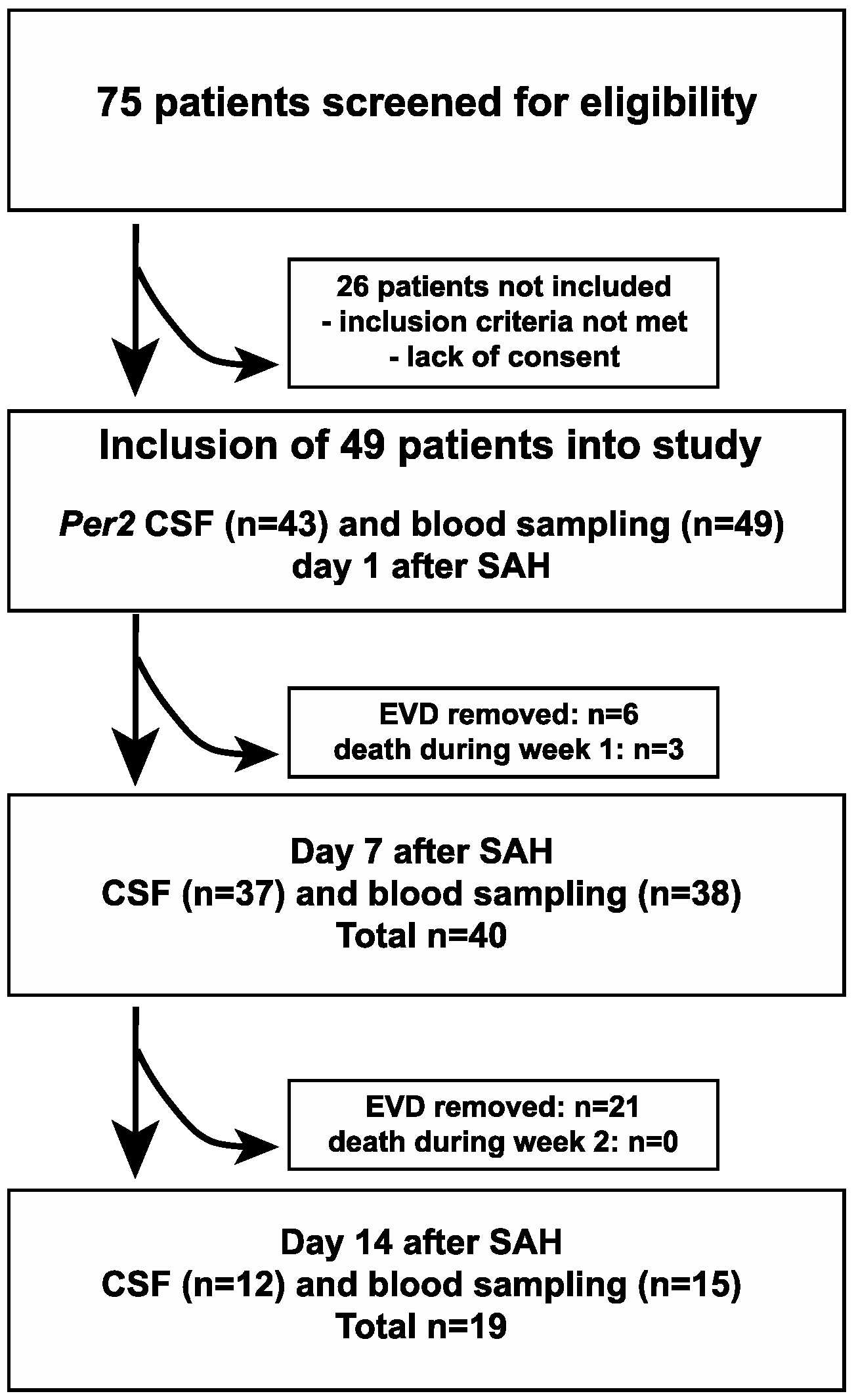
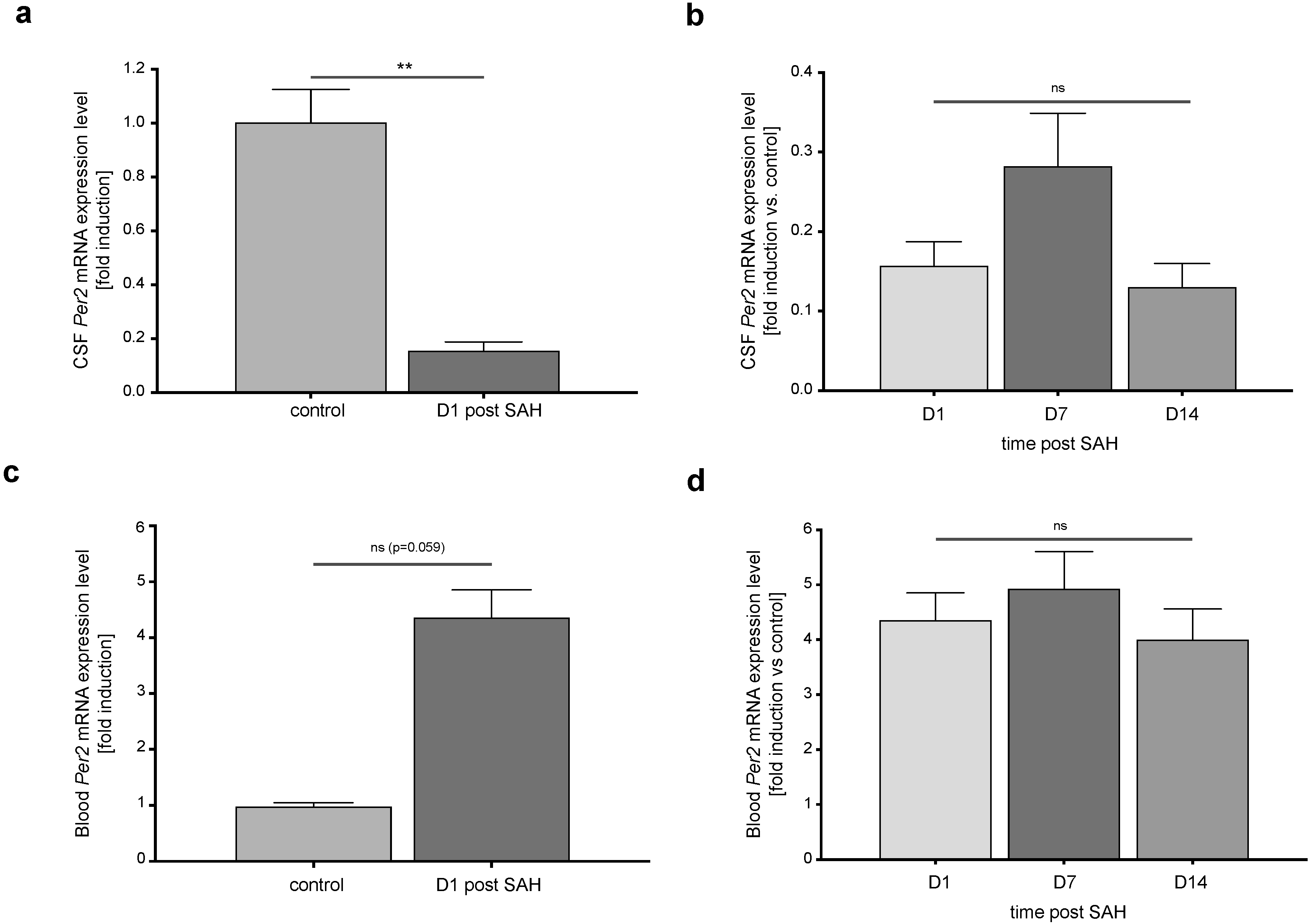
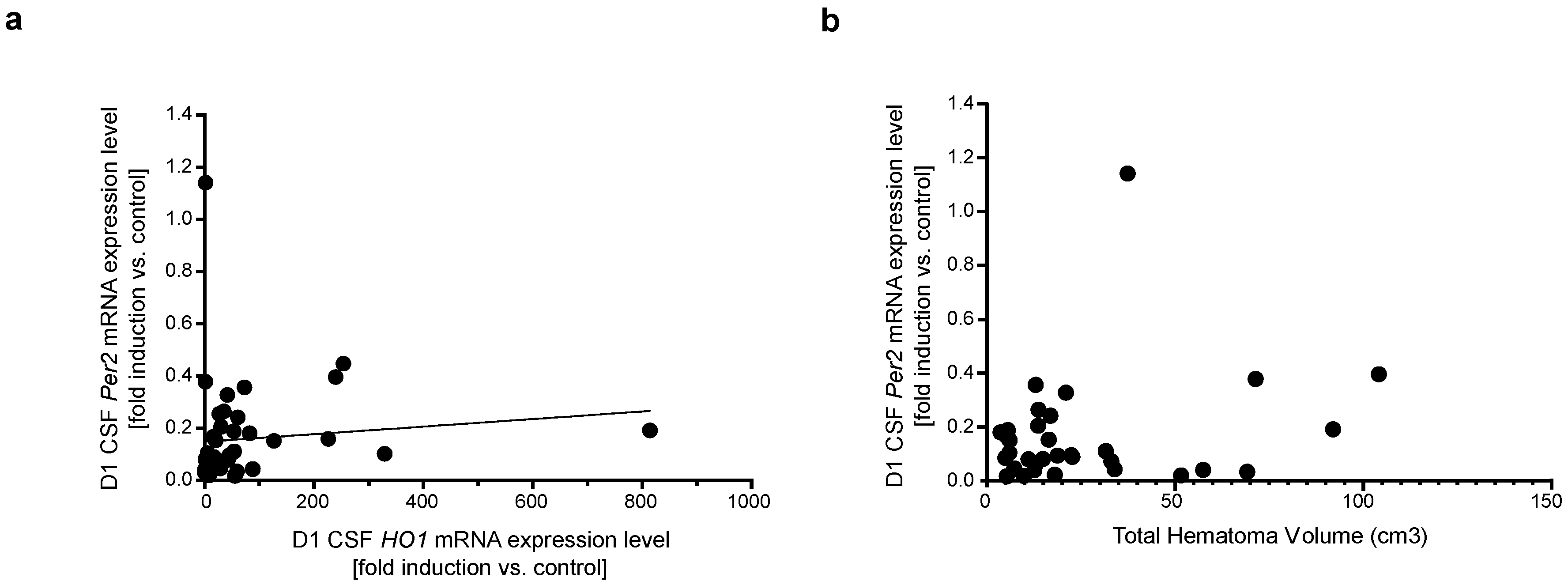
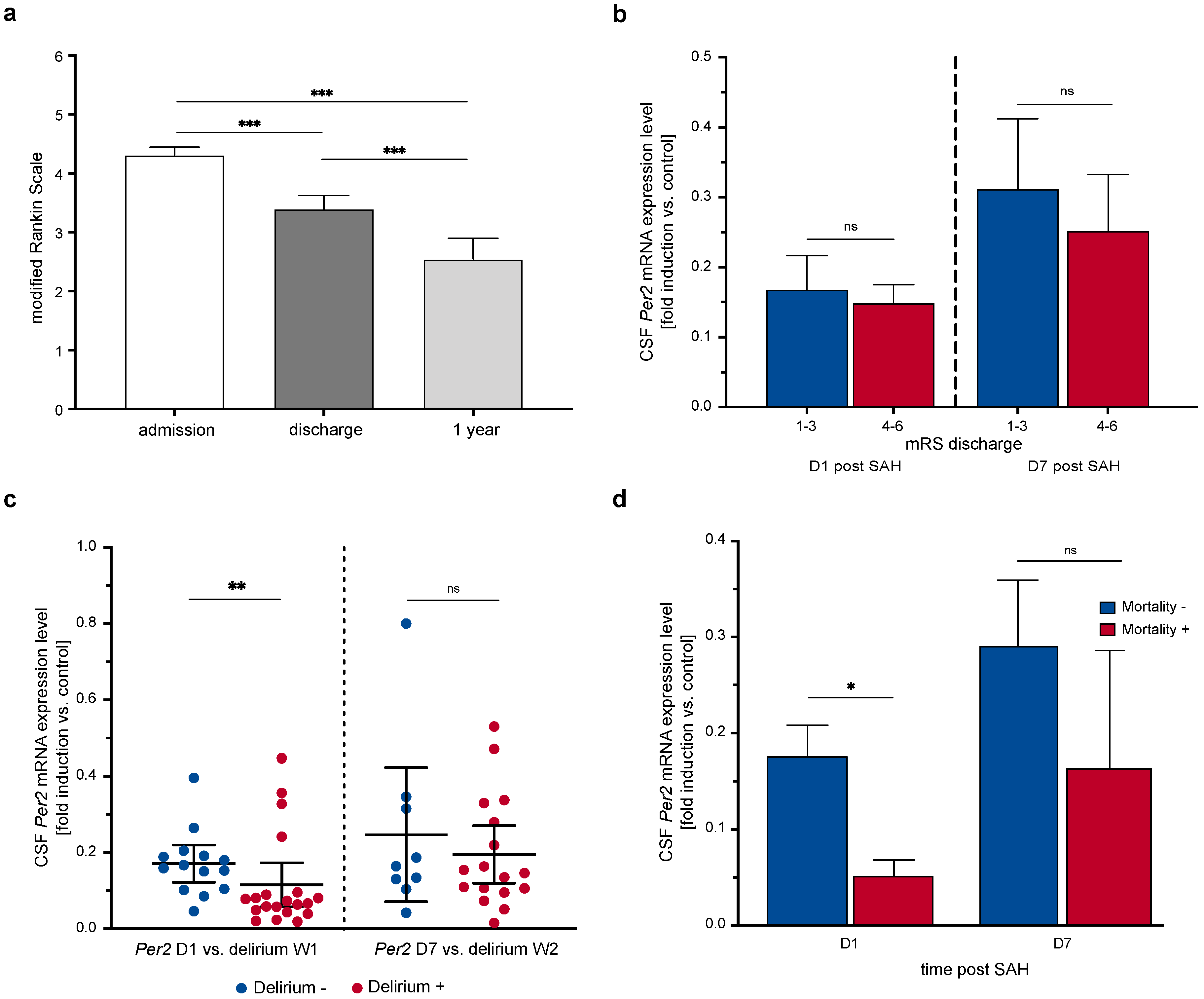
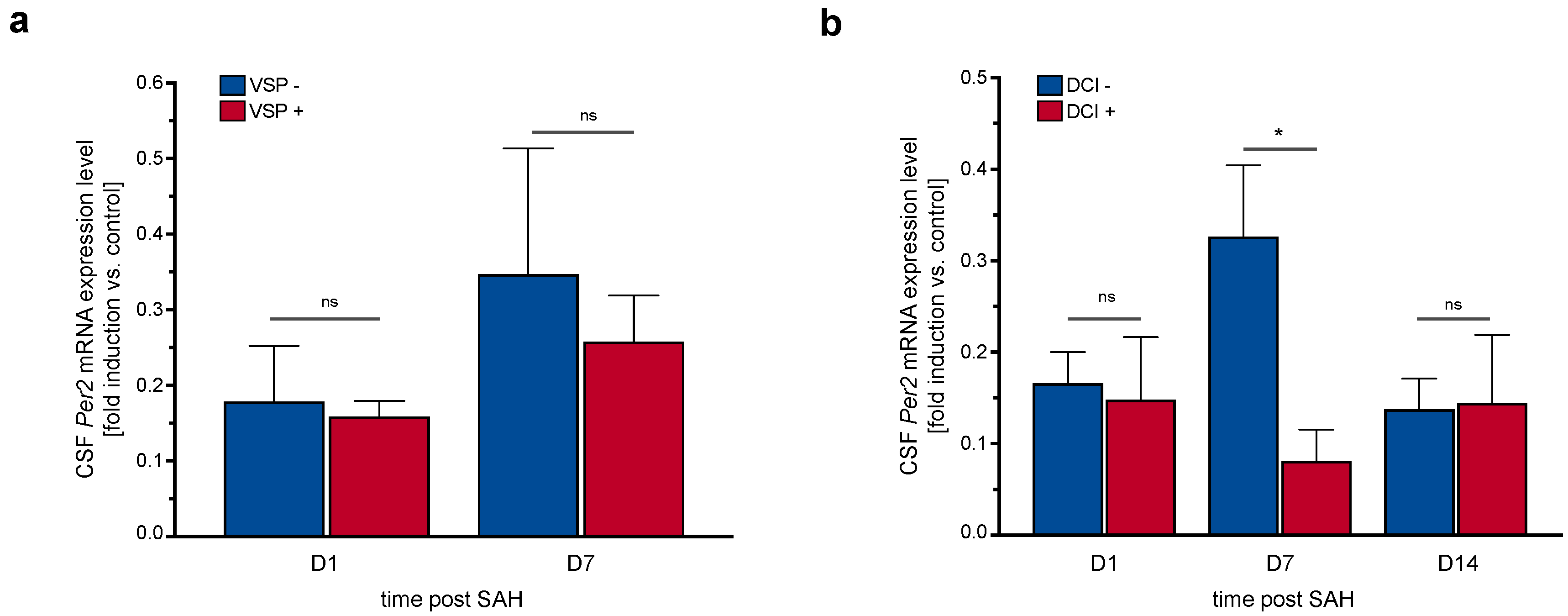
| Mean ± SD | n | |
|---|---|---|
| Age | 57.63 ± 13.71 | 49 |
| Modified Rankin Scale | ||
| on admission | 4.30 ± 0.96 | 49 |
| at discharge | 3.39 ± 1.64 | 49 |
| 1 year after SAH | 2.54 ± 2.17 | 37 |
| SAH severity scales | ||
| Hunt & Hess grade | 3.22 ± 1.18 | 49 |
| WFNS grade | 3.32 ± 1.43 | 47 |
| Modified Fisher grade | 3.65 ± 0.67 | 46 |
| Total hematoma volume (cm3) | 24.65 ± 24.99 | 38 |
| Hijdra Sum Score | 23.67 ± 9.52 | 45 |
| Primer Sequence | |
|---|---|
| HO1 forward | GTGATAGAAGAGGCCAAGACTG |
| HO1 reverse | GAATCTTGCACTTTGTTGCTGG |
| Per2 forward | TCCTCGGCTTGAAACGGC |
| Per2 reverse | GAACGAAGCTTTCGGACCTCA |
| Rpl13a forward | CGGACCGTGCGAGGTAT |
| Rpl13a reverse | CACCATCCGCTTTTTCTTGTC |
| Per2 mRNA Expression Levels [Fold Induction vs. Control] | Spearman r | p-Value | n |
|---|---|---|---|
| CSF | |||
| Day 1 | −0.254 | 0.100 | 43 |
| Day 7 | 0.014 | 0.932 | 37 |
| Day 14 | −0.081 | 0.804 | 12 |
| Blood | |||
| Day 1 | 0.290 | 0.046 | 48 |
| Day 7 | 0.162 | 0.330 | 38 |
| Day 14 | 0.588 | 0.018 | 16 |
| CSF Per2 mRNA Expression Level [Fold Induction vs. Control] | Day 1 | Day 7 | ||||
|---|---|---|---|---|---|---|
| Mean ± SD | n | p-Value | Mean ± SD | n | p-Value | |
| Modified Rankin Scale discharge | ||||||
| 1–3 | 0.167 ± 0.236 | 23 | 0.763 | 0.311 ± 0.452 | 20 | 0.557 |
| 4–6 | 0.148 ± 0.122 | 20 | 0.250 ± 0.337 | 17 | ||
| Vasospasm | ||||||
| negative | 0.177 ± 0.290 | 15 | 0.119 | 0.346 ± 0.580 | 12 | 0.572 |
| positive | 0.157 ± 0.112 | 25 | 0.257 ± 0.295 | 23 | ||
| Delayed cerebral ischemia | ||||||
| negative | 0.165 ± 0.204 | 34 | 0.791 | 0.325 ± 0.431 | 30 | 0.012 |
| positive | 0.148 ± 0.154 | 5 | 0.079 ± 0.079 | 5 | ||
| Delirium | ||||||
| negative | 0.171 ± 0.085 | 14 | 0.008 | 0.247 ± 0.229 | 9 | 0.634 |
| positive | 0.115 ± 0.123 | 20 | 0.195 ± 0.147 | 17 | ||
| Mortality | ||||||
| negative | 0.175 ± 0.199 | 37 | 0.017 | 0.290 ± 0.408 | 35 | 0.675 |
| positive | 0.051 ± 0.041 | 6 | 0.163 ± 0.173 | 2 | ||
Publisher’s Note: MDPI stays neutral with regard to jurisdictional claims in published maps and institutional affiliations. |
© 2021 by the authors. Licensee MDPI, Basel, Switzerland. This article is an open access article distributed under the terms and conditions of the Creative Commons Attribution (CC BY) license (http://creativecommons.org/licenses/by/4.0/).
Share and Cite
Frase, S.; Kaiser, S.; Steimer, M.; Selzner, L.; Foit, N.A.; Niesen, W.-D.; Schallner, N. Patients with Subarachnoid Hemorrhage Exhibit Disturbed Expression Patterns of the Circadian Rhythm Gene Period-2. Life 2021, 11, 124. https://doi.org/10.3390/life11020124
Frase S, Kaiser S, Steimer M, Selzner L, Foit NA, Niesen W-D, Schallner N. Patients with Subarachnoid Hemorrhage Exhibit Disturbed Expression Patterns of the Circadian Rhythm Gene Period-2. Life. 2021; 11(2):124. https://doi.org/10.3390/life11020124
Chicago/Turabian StyleFrase, Sibylle, Sandra Kaiser, Matti Steimer, Lisa Selzner, Niels Alexander Foit, Wolf-Dirk Niesen, and Nils Schallner. 2021. "Patients with Subarachnoid Hemorrhage Exhibit Disturbed Expression Patterns of the Circadian Rhythm Gene Period-2" Life 11, no. 2: 124. https://doi.org/10.3390/life11020124
APA StyleFrase, S., Kaiser, S., Steimer, M., Selzner, L., Foit, N. A., Niesen, W.-D., & Schallner, N. (2021). Patients with Subarachnoid Hemorrhage Exhibit Disturbed Expression Patterns of the Circadian Rhythm Gene Period-2. Life, 11(2), 124. https://doi.org/10.3390/life11020124






